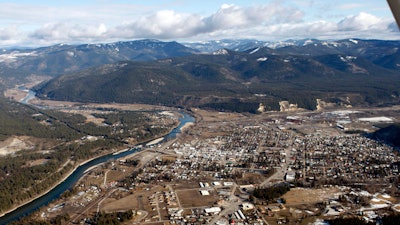
HELENA, Mont. (AP) — An attorney for two people who died of a rare lung cancer argued on Monday for a jury to hold BNSF Railway responsible for pollution in a small Montana town near the U.S.-Canada border where thousands of people were exposed to toxic asbestos dust.
The railroad — now owned by Warren Buffett's Berkshire Hathaway Inc. — hauled asbestos-tainted vermiculite from a nearby mine through Libby, Montana, over decades. How much BNSF knew about the health hazard from those shipments is it at the center of a weekslong civil trial that began Monday.
Attorneys for the railroad said it was told repeatedly that the product it was shipping through Libby was safe.
The U.S. Environmental Protection Agency in 2009 declared the first-ever public health emergency during a Superfund cleanup in Libby. It's one of the deadliest sites under the federal pollution program.
The W.R. Grace & Co. mine that operated most of last century on a mountaintop outside Libby produced contaminated vermiculite that health officials say has sickened more than 3,000 people and led to several hundred deaths.
The pollution has been largely cleaned up. Yet the long latency period of asbestos diseases has meant people have continued getting sick with lung problems.
The estates of Thomas Wells of LaConner, Oregon, and Joyce Walder of Westminster, California, filed a wrongful death lawsuit against BNSF in 2021. They argue the railroad and its corporate predecessors stored asbestos-laden vermiculite in a large rail yard in Libby — before shipping it to plants across the U.S. where it was heated to expand for use as insulation in millions of homes and businesses.
Plaintiffs' attorney Mark Lanier said the dangers of asbestos were well known by the industry yet BNSF never took steps to warn the people of Libby. He added that W.R. Grace, the mining company, started putting warning signs on its vermiculite rail cars as early as 1977.
The trial, Lanier said, was about "did (the railroad) expose Libby residents to wind-born asbestos contamination."
BNSF attorney Chad Knight said the railroad was required under law to accept the vermiculite for shipment and had been told by W.R. Grace that it was safe. The onus was on the shipper to tell the railroad if it was hazardous, Knight said.
Numerous other lawsuits alleging BNSF exposed Libby residents to asbestos are pending, court records show.
The Walder and Wells lawsuit is the first so-called community exposure case against BNSF to go to trial, almost 25 years after federal authorities arrived in Libby following news reports about widespread deaths and illnesses.
People who lived and worked in Libby breathed in the microscopic needle-shaped asbestos fibers that can cause lung scarring and the lung cancer mesothelioma, the lawsuit argues.
Wells, 65, died in March 2020, a day after giving a 1/2-hour recorded deposition for the lawsuit. He talked about his exposure during seasonal work for the U.S. Forest Service in the Libby area in late 1970s and early 1980s.
Wells said he was diagnosed with mesothelioma in late 2019 after feeling an ache in his back and developing a serious cough. He said the pain was intolerable and that he had to sell his house to help cover medical bills.
Walder 66, died in October 2020. She lived in Libby for at least 20 years and could have been exposed to asbestos while fishing and floating on a river that flowed past a spot where vermiculite was loaded onto train cars, according to court records. Her exposure may have also come from playing around a baseball field near the rail yard or walking along the railroad tracks and occasionally heating up pieces of vermiculite to watch it puff up, the records said.
The trial, presided over by U.S. District Court Judge Brian Morris, is expected to last three weeks.
BNSF said in court documents filed in advance of the trial that when low levels of asbestos were found in the Libby rail yard during testing in 2001, the railroad cleaned up the site to protect its employees.
But an expert for the plaintiffs said BNSF and its predecessors sponsored geologic reports in the area and knew as early as the 1920s that the vermiculite mined near Libby had asbestos. By the 1930s the railroad would have known asbestos exposure could be hazardous, based on research disseminated at the time through the Association of American Railroads, said plaintiffs' expert Julie Hart, who chairs the Department of Safety, Health and Industrial Hygiene at Montana Technological University.
Late Sunday night, the railroad requested a last-minute delay in the trial and a change of venue to a different state, citing a weekend story by The Associated Press about the trial and asbestos contamination in Libby. Attorneys for the railroad said prospective jurors would be prejudiced by the article, which quoted a 61-year-old Libby resident who has an asbestos-related disease as saying he used to play in and around the rail yard.
Morris instead allowed the trial to proceed after telling attorneys not to talk to the news media while it's ongoing.
Another case against BNSF Railway alleging community — rather than work-related — exposure to asbestos is scheduled to go to trial next month in U.S. District Court in Missoula. It was brought by the estate of Mary Diana Moe, 79, who died of mesothelioma in December 2022.






















